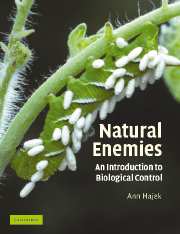Book contents
- Frontmatter
- Contents
- Preface
- Acknowledgments
- Introduction
- PART I Strategies for using natural enemies
- PART II Biological control of invertebrate and vertebrate pests
- Chapter 6 Ecological basis for use of predators, parasitoids, and pathogens
- Chapter 7 Predators
- Chapter 8 Insect parasitoids: attack by aliens
- Chapter 9 Parasitic nematodes
- Chapter 10 Bacterial pathogens of invertebrates
- Chapter 11 Viral pathogens
- Chapter 12 Fungi and microsporidia
- PART III Biological control of weeds
- PART IV Biological control of plant pathogens and plant parasitic nematodes
- PART V Biological control: concerns, changes, and challenges
- Glossary
- References
- Index
Chapter 12 - Fungi and microsporidia
Published online by Cambridge University Press: 05 June 2012
- Frontmatter
- Contents
- Preface
- Acknowledgments
- Introduction
- PART I Strategies for using natural enemies
- PART II Biological control of invertebrate and vertebrate pests
- Chapter 6 Ecological basis for use of predators, parasitoids, and pathogens
- Chapter 7 Predators
- Chapter 8 Insect parasitoids: attack by aliens
- Chapter 9 Parasitic nematodes
- Chapter 10 Bacterial pathogens of invertebrates
- Chapter 11 Viral pathogens
- Chapter 12 Fungi and microsporidia
- PART III Biological control of weeds
- PART IV Biological control of plant pathogens and plant parasitic nematodes
- PART V Biological control: concerns, changes, and challenges
- Glossary
- References
- Index
Summary
The remaining groups of invertebrate pathogens that have been exploited for biological control, the fungi and microsporidia, are eukaryotes. Although these groups share this more-advanced state of having nucleated cells, the fungi and microsporidia are vastly different groups.
Fungal pathogens of invertebrates
Fungi utilize a great diversity of resources as potential sources of nutrients but they need preformed organic matter for food. With this basic nutritional requirement, it seems logical that some fungi would have adopted life styles as pathogens. We will discuss fungi later as natural enemies attacking weeds (Chapter 15) and as both plant pathogens and antagonists of plant pathogens (Chapters 16 and 17). Although fungi are only very rarely lethal pathogens of vertebrates, they are important pathogens of many invertebrates. In fact, there are over 700 species of fungi that are pathogens of arthropods alone.
Among pathogens of arthropods, fungi are unique because most do not need to be eaten since they can penetrate directly through the cuticles of hosts. The microscopic reproductive units of fungi are called spores. First, a fungal spore must land on the surface of a potential host. If it can attach to the cuticle and is not inhibited, the spore will begin to grow and differentiate. The fungus can then penetrate the host cuticle, using both mechanical pressure and enzymes to digest the cuticle as it grows. Once within the hemocoel, the fungus increases, initially as single cells within the insect blood.
- Type
- Chapter
- Information
- Natural EnemiesAn Introduction to Biological Control, pp. 203 - 214Publisher: Cambridge University PressPrint publication year: 2004



